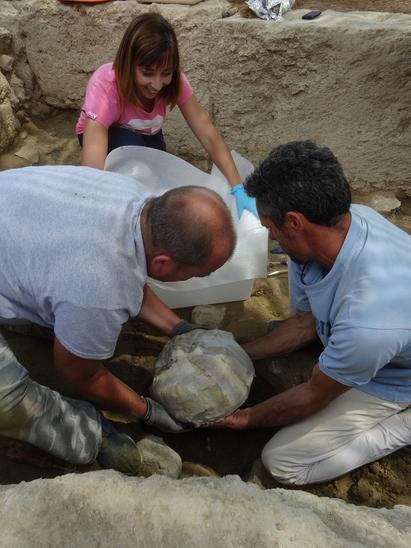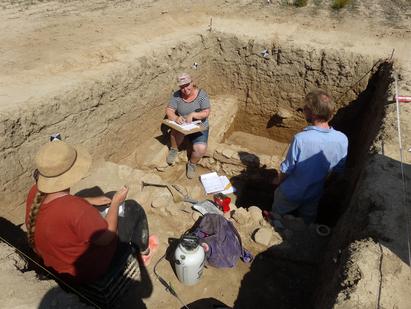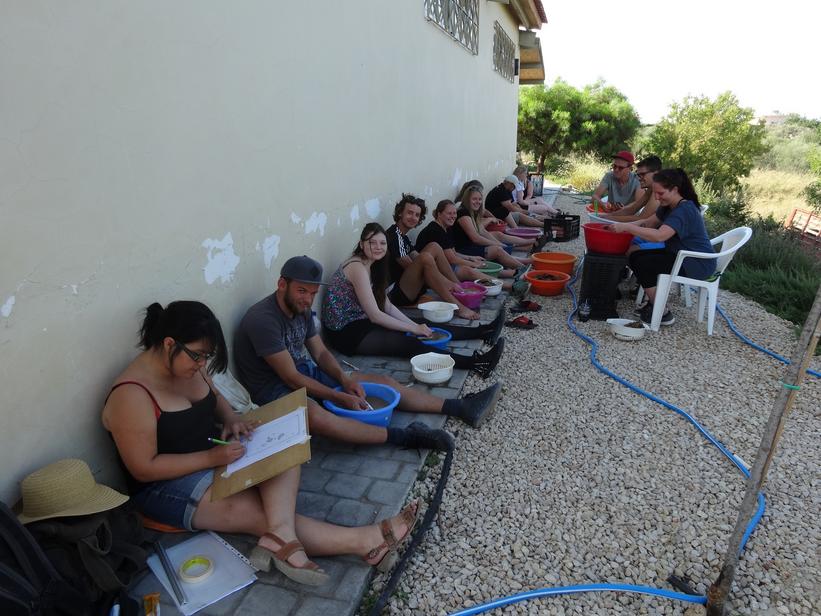Summer campaign 2018
Fieldwork in Sikyon in 2018 was carried out in July and early August and was again primarily dedicated to excavation. It also included a geoarchaeological survey (by Chris Hayward/University of Edinburgh) and the drawing and study of architectural blocks (by Nils Hellner and Thomas Roland Jensen). In addition to the permanent staff and external experts, 26 students of Classical Archaeology from the Universities of Copenhagen, Aarhus, Crete and Oslo as well as one conservation student from the Technological Educational Institute of Athens and 16 workers took part in this season (Fig. 30). The excavations revealed domestic contexts, remains of a public or cultic building and a suburban burial area, all from the Classical or early Hellenistic periods, as well as a Byzantine industrial building in another suburban area (Fig. 31). 3D documentation was employed for the first time (by Toke Hansen, Copenhagen) and permits the three-dimensional visual reconstruction of the excavation process in all layers including the position of architecture and important finds, thus facilitating the interpretation of the ancient contexts and remains in the single trenches (Fig. 32).
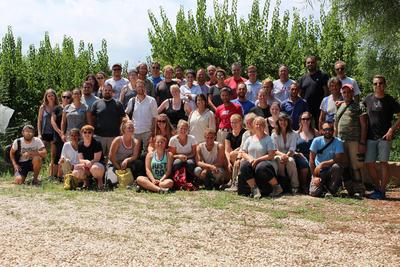

Nine trenches were opened in six different fields (Fig. 33), four of which had already been started in the 2017 season. In Field 1, an extension of last year’s trench to the east revealed that what formerly had been interpreted as a somewhat askew late Geometric/early Archaic wall was in reality a strange arrangement of covering stones for a grave dating to the same period. No traces of early architecture were revealed in this trench. In Field 3, the Classical building structures in Trench 3A were further examined by extending the trench to the north, east and south. The monumental wall already found in 2017 was excavated down to bedrock and probably dates to the first half of the 4th c. BC, although its function cannot be specified yet. In the second half of the 4th c. BC, this wall was included in a room of hitherto undefined function constructed of rubble walls to the west of it, which yielded large amounts of pottery (Fig. 34) and tiles as well as terracotta figurines. These finds together with the monumental wall point to a public or cultic use for this structure, which was covered by a massive fill in the early 3rd c. BC (i.e. after the destruction of the old town).
In Field 4, both trenches from 2017 were extended southwards. In the southern part of Trench 4A, a late Classic/early Hellenistic grave district was discovered, which on its northern side was bordered by a channel that was at some point filled with earth and covered by slabs to form a wall. North of this wall, a road characterised by different surfaces and repairs of Classical times ran in an east-west direction, i.e. between the city and the harbour, and was bordered by a wall on its northern side. Trench 4B yielded the corner of a wall of large, partly reused blocks generously laid in mortar, which could have defined a grave precinct or could have had other funerary functions. A new trench was opened in Field 6 south of the church of Ag. Varvara because of anomalies in georadar measurements discovered in 2016 and revealed a Byzantine structure of some production purpose and Byzantine graves in connection with this structure. The establishment of earlier phases under this structure will be a task of future seasons. The pile of blocks used in the former church of Ag. Varvara was stripped to the ground, the blocks being arranged in the lapidarium and further investigated.
In field 7 in the northern area of Old Sikyon, 3 trenches were laid out on anomalies discovered in resistivity measurements. Trench 7A yielded Classical building structures (a room, a corridor (?), a drain and the remains of floors; Fig. 35) connected to a large complex, including destruction layers from the late 4th c. BC, maybe corresponding to the time of destruction of the town. Through Trench 7B, a linear anomaly crossing the whole field was investigated, as it was suspected to represent part of the fortification wall, but this theory could not be confirmed. Trench 7C revealed the front of a late Classical or early Hellenistic grave monument of very fine execution. In field 9 in the area of the core of the old town, a trench was opened because of anomalies in the geomagnetic measurements and finds of domestic architecture in previous rescue excavations. The corner of a room with a mortar floor and a corridor to the south of it were excavated and seem to belong to a private house from the second half of the fourth c. BC.
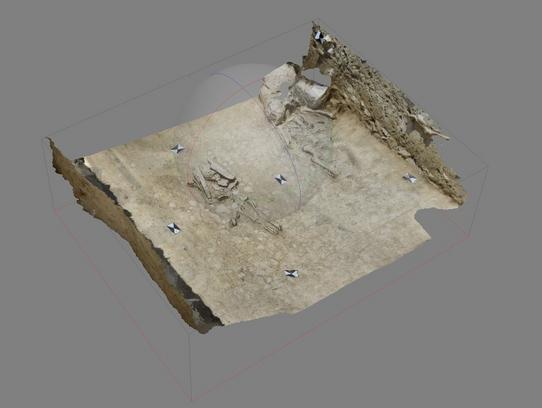
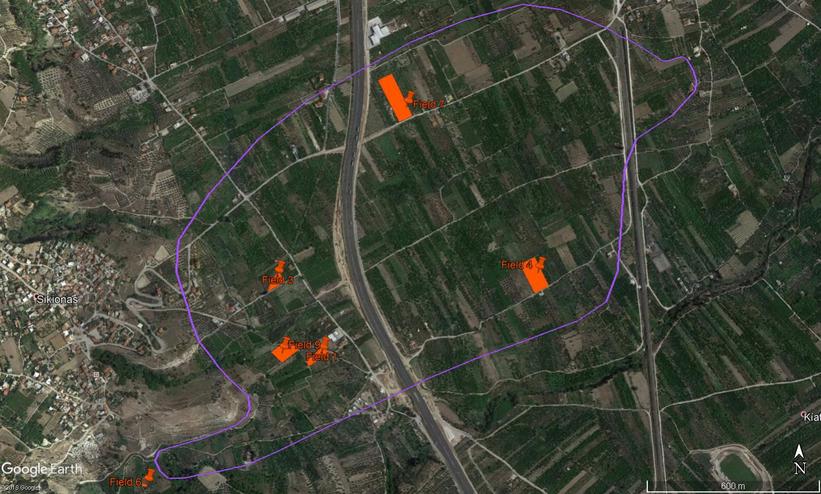
All finds were again processed in the Ephorate’s depot (Fig. 36). The dating of the pottery from all the trenches ranges from the Helladic period to the Byzantine. The excavated fields, except Field 6, all yielded pottery from the Classical period. Field 1 yielded the earliest pottery, while many well-preserved vessels of both cooking ware and fine ware, among which was a lot of fine-quality symposium ware from Attica and Corinth, many loom weights and some figurines were excavated in Field 3 (Fig. 34). The graves of Field 4 yielded well-preserved fine ware miniatures, Corinthian fine symposium ware and several cooking vessels. The majority of the Byzantine pottery comes from Field 6 alongside almost 1000 shells and 3000 tile fragments. A total of nine coins was recovered from the trenches and studied by prof. Michael Ierardi (Bridgewater State University). Most of them are from the 4th c. BC and Sikyonian, others come from Corinth, Pheneos, Euboea and Trachinia. The stone objects were studied by Pernille Foss (University of Copenhagen). Conservation of some special finds and fragile architectural elements was performed directly during the season (by Angeliki Kandri; Fig. 34). Soil samples were collected again from the individual trenches and were processed through flotation. In a preliminary examination, cereals (barley and wheat), lentils, grapes, olives, figs and almonds were identified.
In the geoarchaeological survey, the quarrying activity close to the village of Palaiochori east of Old Sikyon was further investigated and showed that exploitation of biopelsparrite was extensive. Furthermore, all 2018 excavation trenches with exposed masonry and bedrock as well as the remaining blocks used in the older church of Ag. Varvara were examined to identify the lithologies present, which seem to be partly local and possibly partly imported. Another focus of this survey was the search for exploitable stone resources and ancient quarries in the wider Sikyonian region as well as the search for clay resources suitable for exploitation, which will help tracing the origin of Sikyonian pottery.
With the manifold research in 2018, we have again gathered a huge amount of valuable information and come a huge step further in our knowledge about the topography and culture of Old Sikyon. The finds of this year’s season include some excellent pieces and offer valuable chronological information as well as details about the city’s own arts and crafts and its trade with other poleis through imported wares.
